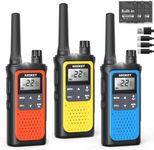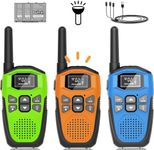Buying Guide for the Best Walkie Talkies
Choosing the right walkie-talkie can make communication much easier, whether you're using it for outdoor adventures, work, or keeping in touch with family. The best way to pick a walkie-talkie is to think about where and how you'll use it most often. Consider the environment, the number of people involved, and how far apart you'll be. Understanding the main features will help you find a model that fits your needs and ensures reliable communication.RangeRange refers to the maximum distance over which two walkie-talkies can communicate clearly. This is important because it determines how far apart you and your group can be while still staying in touch. Manufacturers often list the maximum range under ideal conditions, like open fields with no obstacles, but real-life range is usually less due to buildings, trees, or hills. Short-range walkie-talkies (up to 1 mile) are good for indoor or close outdoor use, medium-range (1-5 miles) work well for parks or neighborhoods, and long-range (5 miles or more) are best for hiking, camping, or large outdoor events. Think about where you'll use the walkie-talkie most and choose a range that covers your typical distance.
Number of ChannelsChannels are like different lanes for conversations, allowing multiple groups to use walkie-talkies in the same area without interfering with each other. More channels mean more options to avoid interference from other users. Basic models may have a few channels, which is fine for small groups or private areas, while advanced models can have dozens, which is helpful in crowded places or for larger groups. If you expect to use your walkie-talkie in busy areas or with many people, look for more channels to ensure clear communication.
Battery LifeBattery life tells you how long the walkie-talkie will work before needing a recharge or new batteries. This is important if you'll be using it for long periods or in places where charging isn't easy. Some walkie-talkies use regular AA or AAA batteries, while others have rechargeable battery packs. Short battery life (a few hours) is fine for quick trips, medium (8-12 hours) suits day-long outings, and long battery life (over 12 hours) is best for camping or work shifts. Choose based on how long you'll need the walkie-talkie to last between charges or battery changes.
Durability and Weather ResistanceDurability and weather resistance describe how well the walkie-talkie can handle drops, dust, and water. This is important if you'll use it outdoors, in rough conditions, or with kids. Some models are basic and best for indoor use, while others are rugged, shockproof, or even waterproof. If you plan to use your walkie-talkie in the rain, on hikes, or at construction sites, look for models with higher durability and weatherproof ratings.
Size and WeightSize and weight affect how easy it is to carry and use the walkie-talkie. Smaller, lighter models are easier to carry in a pocket or for kids, while larger ones may have more features but can be bulky. If portability is important, choose a compact and lightweight model. If you need more features or don't mind a bit of extra weight, a larger model might be suitable.
Privacy CodesPrivacy codes, sometimes called CTCSS or DCS codes, help reduce interference by allowing you to filter out other conversations on the same channel. This is useful in crowded areas where many people use walkie-talkies. If you want more private or uninterrupted communication, look for models with privacy code options. If you'll use your walkie-talkie in quiet areas or with a small group, this feature may be less important.

















